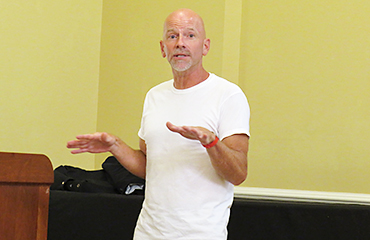
For many people, work and play are opposites, but not for Lander University Professor of Art Doug McAbee.
“I go to school and play every day,” he said.
“To make it as an artist, you have to be willing to work all the time,” according to McAbee, the first speaker of the year in Lander’s Community Lecture Series. The key, therefore, is to “find a way to make that fun.”
He tries to do the same thing in the classes he teaches. He believes that if students are put in a safe environment in which they are “able to play,” they can “do amazing things,” he said.
A chief source of inspiration for McAbee, a sculptor and 2-D artist whose works have been exhibited widely, was Fred Rogers, creator of the television show, “Mister Rogers’ Neighborhood.”
“Fred and I go way back,” he said.
Another was his father, a vocational instructor who taught him how to weld when he was seven. The first of many odd sculptures McAbee has created over the years was a three-legged thing, made of scrap steel.
“It was the coolest thing, because it didn’t exist. And then I made it, and it did exist. That was the thing that got me into being an artist and being creative,” he said.
Making sculptures out of steel is an arduous and sweaty process of cutting the steel, bending it, welding it, grinding it, sanding it, polishing it and painting it.
“It’s a challenge for me, every single day,” he said.
His goal is to create “something that doesn’t look like steel at all,” that “looks like plastic.”
When he tells people unfamiliar with his work that his sculptures are made out of steel, “they don’t believe me,” he said.
McAbee’s sculptures are named after people, but they are unlikely to remind you of anyone you’ve ever seen. There’s an element of “craziness and nonsense” to what he does, he said.
McAbee’s students often seek more guidance from him than he is willing to give.
“When they come to me and ask, ‘will this work?’ I say, ‘I don’t know. Let’s find out.’” He wants them to experiment with different ways of solving the problem, as he does himself.
In evaluating students, he looks at the process they go through as well as the final products they create. A student who attempts something difficult but doesn’t quite pull it off might make a better grade than one who does something easy and is “done immediately.”
When McAbee finishes a project, “it makes me happy,” he said. He thinks that others should approach work the same way.
“Whatever it is that you do in life, have fun with it,” he said.